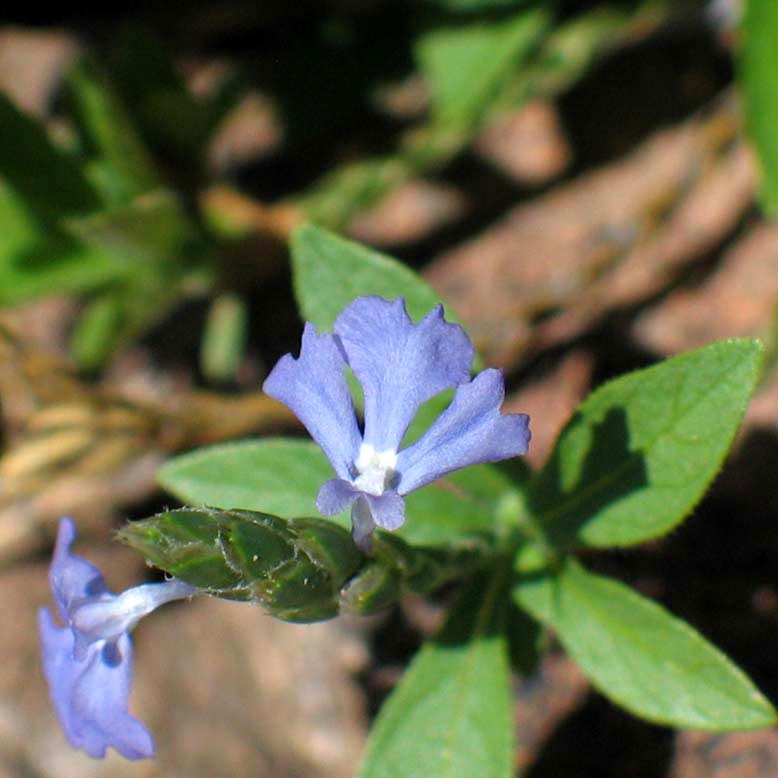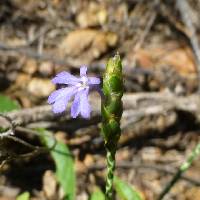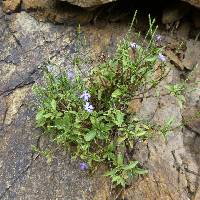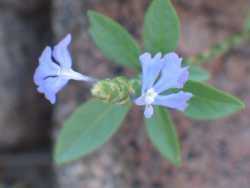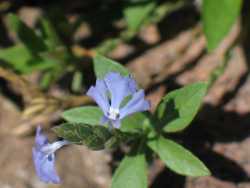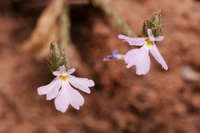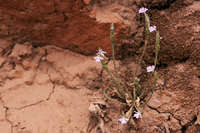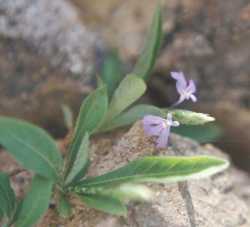|
Family: Acanthaceae
purple scalystem
[Justicia imbricata Pohl ex Nees] |
General: Acaulescent or leaves crowded at tip of a glabrous or sparingly pilose stem to 30 cm long. Leaves: Blades ovate to oblong or obovate, rarely linear–lanceolate, usually 3–12 cm long, 1.5–4 cm wide, blunt or acute at apex, narrowed at base to a slender winged petiole, both surfaces appressed–pilose or glabrate, margins undulate. Flowers: Numerous scapes, axillary, usually 5–24 cm long, simple or branched, covered by tightly appressed, ovate to subulate scales; spikes 1 to several to 6 cm long, bracts oblong to elliptic, 3–6 mm long, 1–2 mm wide, firm, awn–tipped and bearing near apex a pair of triangular or rhombic hyaline teeth; bractlets 3 mm long, calyx segments thin, upper bidentate; corolla narrowly funnelform blue, 5–8 mm long. Fruits: Glabrous capsule. Ecology: Found on dry rocky slopes, banks, or ledges from 3,500–5,000 ft (1067–1524 m); flowers September–May. Distribution: Widely distributed from the southwestern United States south through central Mexico into Central America and South America and into the West Indies. Notes: Widely distributed species, extremely variable in its growth habit, often difficult to see because of its generally diminutive size. Ethnobotany: Unknown Etymology: Elytraria comes from Greek elytron which refers to the scaly envelopes or sheaths of the stem and flower scapes, while imbricata means overlapping, closely put together, referring to the calyx lobes. Sources: Wiggins 1964, Daniel 1984, Kearney and Peebles 1969 Wiggins 1964, Daniel 1984, Kearney and Peebles 1969 Duration: Perennial Nativity: Native Lifeform: Forb/Herb General: Herbaceous perennial; acaulescent or caulescent with leaves crowded at the tip of a glabrous or sparingly pilose stem, to 30 cm long. Leaves: Basal, or subverticillate when caulescent; blades ovate to oblong or obovate, 3-12 cm long, 1-4 cm wide, blunt or acute at apex, tapering into winged petiole, both surfaces appressed-pilose or glabrate, margins undulate. Flowers: Numerous scapes emerging from leaf rosettes, usually 5-24 cm long, simple or branched, covered by tightly appressed, ovate to subulate scales; spikes 1 to several, to 6 cm long, bracts oblong to elliptic, 3-6 mm long, 1-2 mm wide, firm, awn-tipped and bearing near apex a pair of triangular or rhombic hyaline teeth; bractlets 3 mm long; calyx segments thin, the upper bidentate; corolla narrowly funnelform, blue, 5-8 mm long, 2-lipped, with 3 corolla segments pointing up and 2 segments pointing down. Fruits: Capsule glabrous, oblong. Ecology: Found on dry rocky slopes, banks, or ledges; 3,500-5,000 ft (1067-1524 m); flowers September-May. Distribution: sw US through c MEX and C Amer. into S Amer. and the West Indies. Notes: A small herb distinguished by its small growth form and purple to blue, zygomorphic flowers with three lobes above, two lobes below, and a white center, which are borne on a spike of dense, appressed, overlapping bracts with hyaline (beige-white and papery) margins. Widely distributed species, extremely variable in its growth habit, often difficult to see because of its generally diminutive size. Ethnobotany: The Mayo used it in a tea for fevers. Etymology: Elytraria comes from Greek elutron, which means -sheath- or -covering,- referring to the scales along the stem and flower scapes; imbricata means overlapping, closely put together, referring to the arrangement of the bracts and scales. Synonyms: Justicia imbricata Editor: SBuckley 2010, FSCoburn 2014, AHazelton 2015 |

